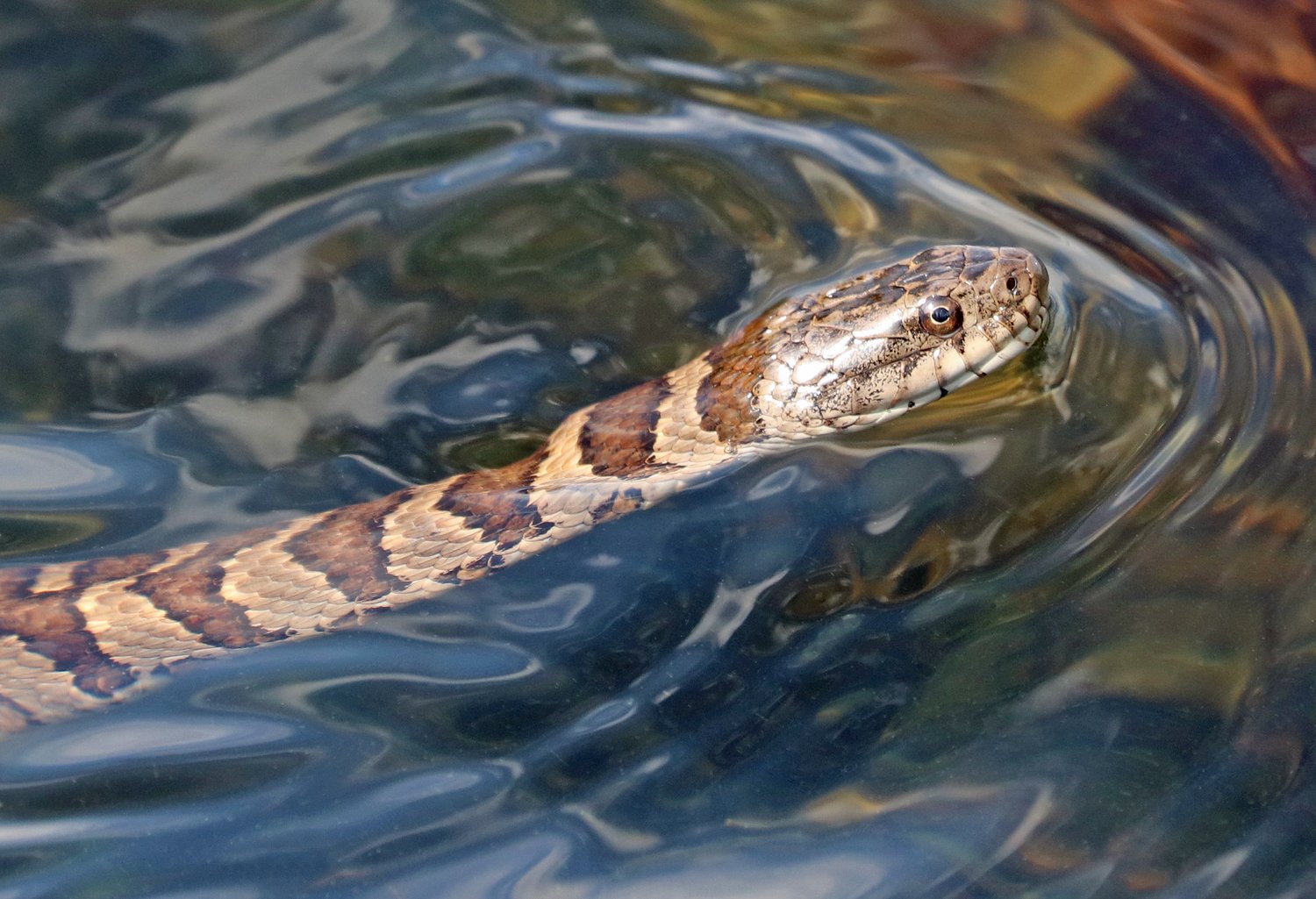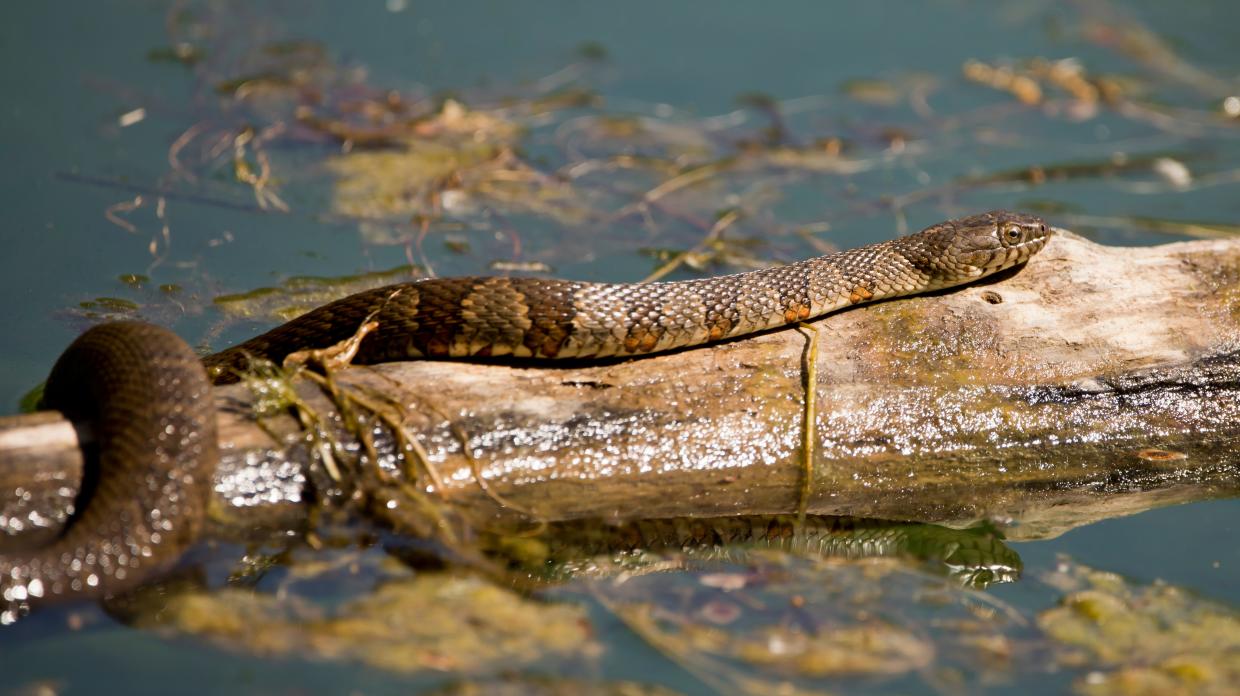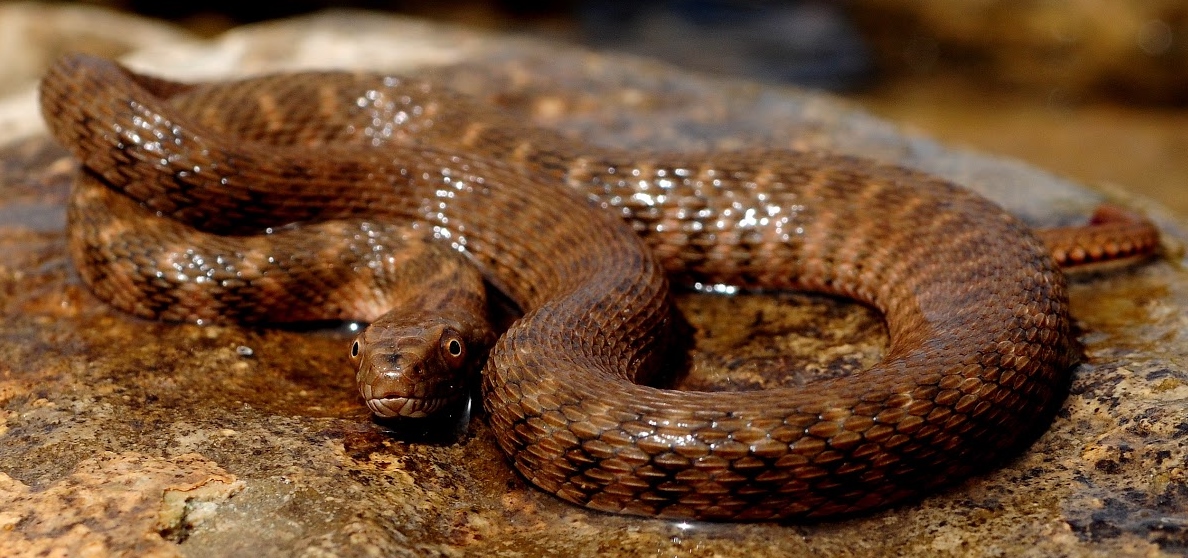Water snakes are fascinating creatures that spend much of their time in or around water. They are non-venomous and are found in North America. There are many different species of water snakes, but in this article, we will discover the 10 types of water snakes that live in the United States.
These snakes can be found in swamps, marshes, ponds, wetlands, streams, and lakes. They like to lounge in branches above water sources or sun themselves on rocks or in open spaces.
You are reading: 10 Types Of Water Snakes That Live In The United States
They dine on toads, fish, frogs, and other creatures that live in or near water. Let’s explore the 10 types of water snakes that call the United States home.

10 Types Of Water Snakes That Live In The United States
Brown Water Snake
The brown water snake (Nerodia taxispilota) is a large, nonvenomous natricine snake that is endemic to the southeastern United States. It is one of the most abundant species of snakes found in rivers and streams of the southeastern United States.
Brown water snakes are stout-bodied and can grow up to 30-60 inches (76-152 cm) in total length, with a record length of 69.5 inches (176.6 cm) . They are light tan with darker squarish brown blotches down the middle of the back, and dark squarish markings also extend upwards from the belly onto the sides of the body between the blotches on the back.
The belly is light-colored with darker blotches and half moons. Brown water snakes are diurnal and feed almost exclusively on freshwater fishes, especially catfishes. They are not aggressive, and striking is only used in defense as a last resort.
When approached, they will typically flee into the water and dive below the surface. If grabbed or pinned, they will typically bite the attacker and release a foul-smelling musk from a pair of glands in the base of the tail.
Brown water snakes are often mistakenly identified as venomous water moccasins, but they are not venomous.
Northern Water Snake

The northern water snake (Nerodia sipedon) is a species of large, nonvenomous, common snake in the family Colubridae. They are some of the most common water snakes in the United States and can be found throughout the eastern half of the country, especially in the Northeast and Midwest.
Northern water snakes have varying shades of brown, gray, or black on their backs with reddish-brown or black bands. They can be seen basking on rocks and prefer slow-moving or standing water near places where they can bask in the sun, such as ponds, vernal pools (seasonal pools of water), and lakes.
Northern water snakes are live-bearers and breed from April to June. They primarily feed on amphibians and fish. Females give birth between late August and early October to live young, having anywhere between 12 and 36 at a time. Their lifespan is nine years in captivity, but it is unknown in the wild.
Northern water snakes are occasionally killed because they are mistaken for “water moccasins”—another name for the venomous cottonmouth.
Green Water Snake
Read more : The Top 5 Groups Of Animals With Exoskeletons
The green water snake (Nerodia cyclopion) is a common species of nonvenomous natricine snake endemic to the southeastern United States. Here are some key facts about the green water snake:
Appearance:
– The green water snake is a heavy-bodied snake that is dark green, olive, or brown dorsally.
– Ventrally, it is yellowish on the anterior third, and the remainder is dark brown with yellow or white semicircles.
– It has one or more small scales under the eye, giving the appearance of a ring of small plates around the eye, a character shared only with the species N. floridana.
– The green water snake averages 76–140 cm (30-55 inches) in total length (including tail).
Habitat:
– The green water snake prefers still waters such as bayous, lakes, marshes, ponds, sluggish streams, and swamps.
– It is sometimes found in brackish water.
Diet:
– The green water snake preys upon crayfish, frogs, and fish.
Reproduction:
– The green water snake is ovoviviparous.
– Mating takes place on land in April.
– The young are born in July or August, and are about 25 cm (10 in) long.
– Brood size varies from 7 to 101, depending on the size of the female.
– The females, which are larger than the males and have two more dorsal scale rows, may weigh over 4.1 kg (9 lb).
It’s worth noting that the Florida green water snake (Nerodia floridana) was once considered a subspecies of the green water snake, but has since been elevated to a full species.
Concho Water Snake
The Concho water snake (Nerodia paucimaculata) is a species of mostly aquatic, nonvenomous snake in the family Colubridae that is endemic to Texas in the United States. Here are some key facts about the Concho water snake:
Appearance:
– The Concho water snake is a small snake that grows up to 3 feet (91 cm) in length.
– It has large dark reddish-brown bands covering its body.
– The belly is light pinkish or orange and is unmarked or has somewhat indistinct spots along the sides.
Habitat:
– The Concho water snake is found only in west-central Texas in the Colorado and Concho river systems, in Coke, Runnels, San Saba, and Tom Green Counties.
– It prefers slow-moving or standing water, such as streams, rivers, and ponds.
Conservation status:
– Due to its limited range, the Concho water snake was considered a threatened species in the state of Texas.
– The U.S. Fish and Wildlife Service listed the Concho water snake as threatened under the Endangered Species Act in 1986.
It’s worth noting that the Concho water snake was originally considered to be a subspecies of the Brazos water snake (Nerodia harteri), but was elevated to full species status in 1992.
Diamondback Water Snake
The diamondback water snake (Nerodia rhombifer) is a species of nonvenomous natricine colubrid that is endemic to the central United States and northern Mexico. Here are some key facts about the diamondback water snake:
Appearance:
– The diamondback water snake is predominantly brown, dark brown, or dark olive green in color, with a black net-like pattern along the back, with each spot being vaguely diamond-shaped.
– Dark vertical bars and lighter coloring are often present down the sides of the snake.
– In typical counter-colored fashion, the underside is generally a yellow or lighter brown color, often with black blotching.
– Neonates are often lighter in color, making their patterns more pronounced, and they darken with age.
– Most adult diamondback water snakes are about 30-60 inches (76-152 cm) in total length, with a record length of 69 inches (175.3 cm).
Habitat:
– The diamondback water snake is found predominantly near slow-moving bodies of water such as streams, rivers, ponds, or swamps.
– It is one of the most common species of snake within its range.
Behavior:
– When foraging for food, the diamondback water snake will hang on branches suspended over the water, dipping its head under the surface of the water until it encounters a fish or other prey.
– It is frequently found basking on branches over water, and when approached, it will quickly drop into the water and swim away.
– If cornered, it will often hiss and flatten the head and body to appear larger.
– It only typically resorts to biting if physically harassed or handled.
It’s worth noting that there are three recognized subspecies of N. rhombifer, including the Mississippi diamondback water snake (N. r. rhombifer), the Texas diamondback water snake (N. r. blanchardi), and the Mexican diamondback water snake (N. r. crotalina).
Yellow-Bellied Water Snake

The yellow-bellied water snake (Nerodia erythrogaster flavigaster) is a subspecies of the plain-bellied water snake (Nerodia erythrogaster), which is a common species of semi-aquatic, non-venomous colubrid snake endemic to the United States. Here are some key facts about the plain-bellied water snake, which includes the yellow-bellied water snake subspecies:
Appearance:
– The plain-bellied water snake has a gray to greenish back and an unpatterned, yellow belly.
– It is a medium-sized, heavy-bodied, dark-colored, semi-aquatic snake.
– The subspecies Nerodia erythrogaster flavigaster, or the yellow-bellied water snake, has a yellow belly and a gray to greenish back.
Habitat:
– The plain-bellied water snake is found in a variety of aquatic habitats, including streams, rivers, ponds, and swamps.
– It is mainly gray, greenish gray, or brown dorsally, and the belly is yellow or orange.
Behavior:
– Plain-bellied water snakes are active during the day and are mostly solitary, although mating can occur in groups of one female and multiple males.
– They are non-aggressive and will typically flee when approached.
– They feed on a variety of prey, including fish, frogs, and crayfish.
It’s worth noting that there are six recognized subspecies of N. erythrogaster, including the plain-bellied water snake (N. e. erythrogaster), the Mississippi plain-bellied water snake (N. e. alta), Bogert’s water snake (N. e. bogerti), the yellow-bellied water snake (N. e. flavigaster), the copperbelly water snake (N. e. neglecta), and the blotched water snake (N. e. transversa).
Banded Water Snake
The banded water snake (Nerodia fasciata) or southern water snake is a species of mostly aquatic, nonvenomous, colubrid snakes most commonly found in the Midwest, Southeastern United States, and Caribbean. Here are some key facts about the banded water snake:
Appearance:
– Banded water snakes are mid-sized, heavy-bodied, semi-aquatic snakes that grow up to 24-48 inches (61-106.7 cm) in length.
– They have brown or grayish backs marked by reddish to dark brown crossbands extending the entire length of the body.
– They have scatterings of square spots on their belly scales.
– This species also has a dark band stretching from the eye to the corner of the jaw, distinguishing them from their close relative, the northern water snake.
– Some old individuals become very dark and are often mistakenly identified as cottonmouths and killed.
Habitat:
– Banded water snakes are common in all types of freshwater aquatic environments in the Coastal Plain of North Carolina, but are most abundant in marshes and ponds.
– They are found in a variety of aquatic habitats, including streams, rivers, ponds, and swamps.
Behavior:
– Banded water snakes feed on a variety of prey, including fish, frogs, tadpoles, and salamanders.
– Females grow larger than males and give birth to 9–57 young in late summer or early fall.
– When threatened, banded water snakes flatten their bodies to appear bigger, emit a foul musk from their anal glands, and bite repeatedly.
– When they bite, they often slash sideways, tearing the flesh of their attacker.
It’s worth noting that there are three recognized subspecies of N. fasciata, including the nominotypical subspecies, N. f. confluens (Blanchard, 1923), and N. f. pictiventris (Cope, 1892).
Florida Green Water Snake
The Florida green water snake (Nerodia floridana) is a species of nonvenomous, semi-aquatic snake that is native to the southeastern United States. Here are some key facts about the Florida green water snake:
Appearance:
– Florida green water snakes are stout-bodied snakes that can grow up to 30-55 inches (76-140 cm) in length.
– They may be greenish, brownish, or orangish in color, with no real distinctive markings other than dark speckling.
– Adults are generally solid greenish-brownish with a yellow or cream-colored belly.
– Juveniles are more brightly colored and have a pattern of dark blotches on a light background.
Habitat:
– Florida green water snakes are found in a variety of aquatic habitats, including streams, rivers, ponds, and swamps.
– They are often found basking on rocks or logs near the water’s edge.
Behavior:
– Florida green water snakes are active during the day and are mostly solitary.
– They feed on a variety of prey, including fish, frogs, and crayfish.
– Females give birth to live young in late summer or early fall.
– Florida green water snakes are sometimes mistaken for the venomous cottonmouth, but they are thinner and have round eye pupils.
It’s worth noting that the Florida green water snake was once considered a subspecies of the plain-bellied water snake (Nerodia erythrogaster), but has since been elevated to a full species.
Saltmarsh Water Snake
The saltmarsh water snake (Nerodia clarkii) is a species of semi-aquatic, nonvenomous, colubrid snake found in the southeastern United States. Here are some key facts about the saltmarsh water snake:
Appearance:
– Saltmarsh water snakes are slender, heavily keeled water snakes that grow up to 2 feet (61 cm) in total length.
– They have a pattern of stripes that are variously broken into spots or blotches.
– The color of their dorsal surface varies from brown to gray, and their ventral surface is yellow or cream-colored.
Habitat:
– Saltmarsh water snakes are found in the brackish salt marshes of the Gulf of Mexico and the Atlantic Coast from Texas to Florida, with an additional population in northern Cuba.
– They prefer to live in salt marshes, tidal creeks, and mangrove swamps.
Behavior:
– Saltmarsh water snakes are active during the day and are mostly solitary.
– They feed on a variety of prey, including fish, frogs, and crayfish.
– Females give birth to live young in late summer or early fall.
– Saltmarsh water snakes are sometimes mistaken for the venomous cottonmouth, but they are thinner and have round eye pupils.
Read more : Discover 14 Types Of Wasps In Texas
It’s worth noting that there are three recognized subspecies of N. clarkii, including the nominotypical subspecies, N. c. clarkii (Goin, 1942), the Gulf saltmarsh water snake (N. c. clarkii), and the Atlantic saltmarsh water snake (N. c. taeniata).
Brazos Water Snake

The Brazos water snake (Nerodia harteri), also known as Harter’s water snake, is a species of mostly aquatic, nonvenomous snake in the family Colubridae. The species is endemic to Texas in the United States and is found only in Central Texas in the Brazos River system. Here are some key facts about the Brazos water snake:
Appearance:
– The Brazos water snake grows to a total length (including tail) of 16 to 32 inches (41–81 cm).
– It ranges in color from brown to olive green.
– It has two rows of spots that go down either side of its back, and has a pink or orange underside with dark spots down either side.
Habitat:
– The preferred habitat of the Brazos water snake is rocky areas along the Brazos River.
Behavior:
– The Brazos water snake is a fish-eating snake that enjoys residing in water that is fast-flowing and rocky, and free of dense vegetation.
– It is a day-time hunter that requires rocks within its habitat to provide cover and security.
– It typically eats small fish but has been recorded eating a variety of salamanders, frogs, and crayfish.
– Females give birth to as many as 23 live young between the months of September and October.
It’s worth noting that the Brazos water snake is sometimes mistaken for the venomous cottonmouth, but it is thinner and has round eye pupils. The species is also considered threatened in the state of Texas.
FAQS
1. What are water snakes?
Water snakes are nonvenomous snakes that spend much of their time in or around water. They are found in North America, Europe, and Asia.
2. How many species of water snakes are there in the United States?
There are 10 species of water snakes that live in the United States.
3. What are the 10 types of water snakes that live in the United States?
The 10 types of water snakes that live in the United States are: Brown Water Snakes, Northern Water Snakes, Green Water Snake, Concho Water Snake, Diamondback Water Snake, Yellow-Bellied Water Snakes, Banded Water Snake, Florida Green Water Snake, Saltmarsh Water Snake, and Brazos Water Snake.
4. Are water snakes venomous?
Water snakes are nonvenomous, but they are sometimes mistaken for venomous snakes like the cottonmouth.
5. What do water snakes eat?
Water snakes feed mainly on fish, amphibians, and other creatures that live in or near water.
6. Where do water snakes live?
Water snakes live in and around rivers, lakes, swamps, and other watery habitats. They like to bask in the sun so seek areas that are not overly shaded.
7. Are water snakes dangerous to humans?
Water snakes are not dangerous to humans, but they may bite if they feel threatened. Their bites are not deadly, but they can hurt.
8. How can I tell the difference between a water snake and a venomous snake?
Water snakes are thinner and have round eye pupils, while venomous snakes like the cottonmouth have triangular heads and vertical pupils.
9. Are water snakes endangered?
Some species of water snakes are endangered due to habitat loss from development.
10. How do water snakes reproduce?
Water snakes reproduce either by laying eggs or giving birth to live young, depending on the species.
Source: https://petstutorial.com
Category: Animals










